
Advance agreements with Latin America will be one of the priorities of the Spanish presidency of the EUas the Minister of foreign affairsJosé Manuel Albares, on the occasion of the summit between the two blocks from July 17 to 18 in Brussels.
The summit should serve to advance trade agreements with Chile, Mexico and Mercosur, which are not only “trade agreements” but the sample “of the long-term political commitment that Europe has towards Latin America”for which Albares has advocated that these agreements be extended in time beyond the Spanish presidency.
The European Union (EU) is the second largest trading partner of the Community of Latin American and Caribbean States (CELAC) and investment is also a crucial pillar of the bi-regional relationship.
The EU continues to be the main investor in the CELAC countries, contributing 35% of the total foreign direct investment received by the region. In addition, the European investment received by Latin America and the Caribbean is greater than the European investment in Russia, China and India combined.
The summits of Heads of State of Government take place every two or three years. The first was held on June 28, 1999 in Brazil and so far there have been eight, the last in 2015, and they have tried to promote free trade, political dialogue and cooperation.
These initiatives have been embodied in agreements with Mercosur, the Andean Community (CAN), Central America and the Caribbean, and in bilateral pacts with Mexico and Chile.
signed agreements
– EU-MEXICO.- Mexico was the first Latin American country to sign, in December 1997, a “Economic Association, Political Coordination and Cooperation Agreement”tending to free trade and which has been in force since October 2000. The EU is its second trading partner, after the US.
Since the entry into force of the Agreement in 2000, EU-Mexico trade has increased by 70%.
– EU-CHILE.- Chile signed an Association Agreement with the EU in November 2002 similar to the Mexican one, which progressively and reciprocally liberalizes market access for goods, services and government purchases, and which both parties decided to update in 2017.
Said update, which took five years and ended last December, renewed the commercial and investment standards and gave way to a new Advanced Framework Agreement, pending ratification by the European Parliament.
In October 2005, both parties had also signed an agreement of “Open skies” to progressively open their air markets to the other party’s airlines.
EU-Chile exchanges have increased by 250% since the signing of the agreement.
– EU-MERCOSUR.- The EU is Mercosur’s first trading partner ((Brazil, Argentina, Paraguay, Uruguay and Venezuela).
In June 2019, the EU and Mercosur reached a Free Trade Agreement in Buenos Aires after twenty years of negotiations, which encompasses a market of almost 800 million people.
However, the ratification has been blocked since then by the veto of various countries of the Union, including France, which requires the South American bloc guarantees in environmental terms and respect for European food safety regulations.
The background dates back to December 1995 when both blocs signed the Interregional Cooperation Framework Agreement in Madrid, during the end of the European presidency of the EU, which was described as a pioneer for being the first between two customs unions.
– EU-ANDEAN COMMUNITY (CAN).- In December 2003, the Political Dialogue and Cooperation Agreement between the EU and the Andean Community (Bolivia, Colombia, Ecuador and Peru) was signed in Rome.
The withdrawal of Venezuela from the CAN, in 2006, delayed the formal opening of negotiations for a subsequent free trade agreement (FTA) and it was not until May 2010 when the negotiations between Colombia and Peru concluded in Madrid during the VI Summit of Chiefs of State and Government of the EU and Latin America and the Caribbean and which was finally signed in 2012.
Ecuador joined the FTA in 2016 and Bolivia did not start trade negotiations after the process to reach an association agreement between the EU and the CAN failed. Only the Generalized System of Preferences Plus (GSP+) prevails, through which tariffs are reduced or eliminated to the Andean country.
– EU-CENTRAL AMERICA (SICA Central American Integration System).- The EU-Central America Association Agreement was signed in 2012 and its objective is to reduce tariffs and increase the efficiency of customs procedures.
– EU-CARIBBEAN.- On December 17, 2007, the European Commission signed an Economic Association Agreement with the CARIFORUM countries: Antigua and Barbuda, Bahamas, Barbados, Belize, Dominica, Dominican Republic, Grenada, Guyana, Haiti, Jamaica, Saint Lucia, Saint Vincent and the Grenadines, Saint Kitts and Nevis, Suriname, and Trinidad and Tobago.
This agreement fully opens the EU market to Caribbean exports and also, gradually, the Caribbean market to new trade from the EU.
The EU is the second largest trading partner of the Caribbean, behind the US, and the destination of 19% of Caribbean exports
Source: EFE
Source: Gestion
Ricardo is a renowned author and journalist, known for his exceptional writing on top-news stories. He currently works as a writer at the 247 News Agency, where he is known for his ability to deliver breaking news and insightful analysis on the most pressing issues of the day.












